Flakey Jake’s

In the eighties, there was a war of competing hamburger chains: Fuddrucker’s versus Flakey Jake’s. I liked them both but slightly preferred the latter, particularly the Flakey Jake’s on the northwest corner of the intersection of Pico and Sepulveda in West Los Angeles.
The premise of both chains was simple. They sold pretty good hamburgers, a notch above McDonald’s and Burger King at a correspondingly (but not exorbitant) price. They both had other menu items but you went there for the burgers, which were served on a bun cooked on the premises in their own bakery. The bakery also made cinnamon buns and other goodies which you could purchase to take home.
One thing I liked about them was the “dress-it-yourself” bar that I first encountered at Woody’s Smorgasburger, which has become the major topic of this site. You got your burger nude and you carried it over to an area where they had ketchup and mustard and onions and lettuce and tomato and cheese sauces and other toppings. The hamburgers at Flakey Jake’s were pretty darned good and I ate at the Pico-Sepulveda one often.
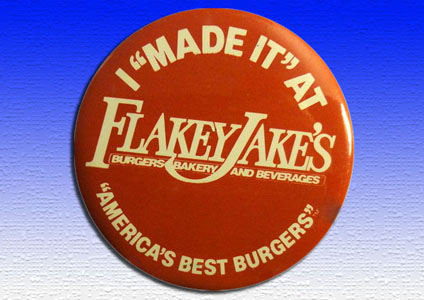
The two chains were in fierce competition to open up new locations across the country — some company-owned, some franchised. In a few cases, they competed head-to-head: There’d be a Flakey Jake’s literally across the street from a Fuddrucker’s. Fuddrucker’s also sued Flakey Jake’s charging “infringement of trade dress” (copying its format) and then Flakey Jake’s counter-sued Fuddrucker’s charging “restraint of trade” and in ’82, they settled out of court on undisclosed terms.
Around this time, Flakey Jake’s, which had been founded by a Seattle-based seafood restaurant chain, sold out to Frank Carney (co-founder of Pizza Hut) and a group of investors. Apparently, they couldn’t make a go of it. Before long, all the Flakey Jake’s closed…or seem to have closed. Fuddrucker’s, meanwhile, continues to thrive and currently has around 200 outlets across the U.S. — few of them, I’m afraid, in areas where I travel. I’m curious why one chain succeeded and the other didn’t because they were, after all, pretty much the same thing.
Chuck’s Steak House
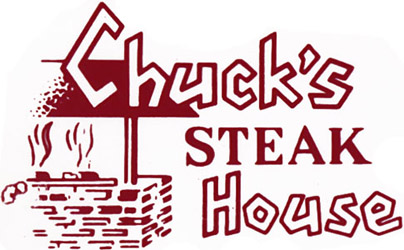
There used to be a number of Chuck’s Steak Houses in Los Angeles and I miss ’em. There are still Chuck’s around — the nearest one seems to be in Santa Barbara — but they do not seem to be a chain, exactly. They seem to be independently-owned places opened with the blessing (and perhaps, financial participation) of this guy Chuck.
Chuck was Chuck Rolles, a former All-American basketball player who opened his first restaurant in Hawaii in 1959. The concept was pretty simple. You could get a good steak, a baked potato or rice and a trip to the salad bar for a reasonable price, and you didn’t have to get all dressed up. One of the features of a Chuck’s Steak House has always been the casual, friendly atmosphere. Another was the self-serve salad bar, which at the time was a relatively new idea. Yet another is or was the simple menu, which at times has fit on the side of a little cask on your table.
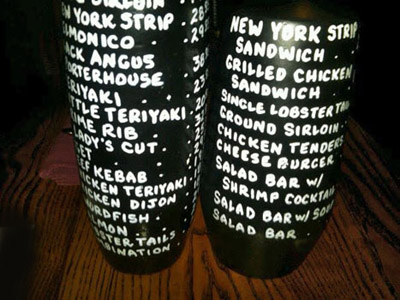
Chuck’s expanded in many directions with various partnerships and my main recollections are of one in Valley at (I think) Sepulveda and Ventura, and another on Third Street near La Cienega, near where I was then living. It was near a studio called the Record Plant where many rock musicians of the seventies recorded very famous albums. I don’t think I ever went to that Chuck’s without seeing someone who was super-famous in the music industry…and if you didn’t recognize them, an obliging waiter would whisper to you something like, “See that guy over by the bar? That’s Phil Spector.”
The Record Plant burned down one night and I have a feeling that contributed to Chuck’s exit from that area. But maybe the Chuck’s people just decided to give up on Los Angeles because that’s what they did. I liked the food there tremendously, especially the rice that came with your steak. You could substitute a baked potato for a few bucks more but the rice was so good, most people learned not to. Folks I dined with were always trying to figure out what they did to the rice to make it so good but the servers would just tell you, “It’s a secret.” A woman I dined with there once claimed the rice had been cooked, then stir-fried in sesame oil. I have no idea if that’s so.
Chuck’s spawned numerous imitators in the seventies. I went to at least three steak places that tried to replicate Chuck’s down to the nth degree…and they usually managed to get everything right except for that rice. None of them caught on. Only Chuck’s was Chuck’s and I wish we still had one in town.
Buddha’s Belly

The Buddha’s Belly on Beverly Boulevard just east of Fairfax closed last September. There’s still a location out in Santa Monica.
The eclectic Pan-Asian restaurant had struggled for some time. The last-ditch effort to keep it open involved turning its private dining room into Buddha’s Lounge (a bar ‘n’ snack place) and then making the place look more like a cocktail lounge. I was never a huge fan of the food there — I was once served an entree that was so overcooked as to be inedible and the management had zero interest in replacing it — but I had friends who loved it. I didn’t much like the parking situation either, and suspect that accounted for some of its problems.
But a lot of people swore by its unique twist on some Asian staples. The magician Ricky Jay seems to have loved it…or maybe it was just coincidence that he always seemed to be at the next table when I ate there. Those who crave its sweet chili shrimp will just have to drive out to Broadway and 2nd by the sea.
Woody’s Smorgasburger II
The comment thread on the original posting here about Woody’s Smorgasburger got so long that we decided to stop it there and start a sequel over there. You can read the old thread here. Please continue the conversation below. And by the way, all this talk has made some of us miss the place all the more.
The Highwayman
This one is so obscure that I don’t have any visual material to post and I can’t find a single mention of the place on the web. When the Century City shopping complex was opened in the mid-sixties, there was a restaurant situated on the main mall, right outside the Broadway department store. It was called the Century House and it was nothing special…a decent place to grab a bite if you were shopping over there but that’s about it. I remember very little about the place and would have forgotten it completely except for what replaced it. (You can see the exterior of the Century House briefly in the 1967 movie, A Guide for the Married Man starring Walter Matthau and Robert Morse. In fact, you can see a number of well-remembered but gone locations in L.A. in that movie including a scene set in Kiddieland, the place over at La Cienega and Beverly that was always filled with divorced fathers taking their kids out for a day.)
Around 1978 (that’s a guess), the Century House closed and its building was taken over by a terrific steakhouse called The Highwayman. It was the work of an Australian restaurateur who had an amazing way of cooking ribeye steaks with some sort of au jus liquid that I loved. But what were really amazing at the Highwayman were the soups. They changed every day and I remember dining there one night with a date, having a Shrimp Bisque and thinking I’d just found the best soup on the planet. I hurried back there with a friend a few days later, raving about the Shrimp Bisque. “I hope you have it tonight,” I said to our server. He said, “I’m sorry but tonight, the chef felt like making Salmon Bisque instead. But I think it’s even better than the Shrimp Bisque.” I said something like, “Nothing could be better than that Shrimp Bisque but let’s give it a try.” As it turned out, he was right. Even better.
I went there often for less than a year and increasingly, the host acted thrilled to see me walk in with my party…because a lot of people weren’t doing that. Apparently, the rent there on the Century City Mall was astronomical and business just wasn’t good enough to overcome it. One afternoon, after touting the place to several friends I planned to take there that evening, I called for reservations and a brusque voice said, “Sorry, we’re out of business” and hung up. I hoped they’d reopen somewhere else but it never happened…and that’s all I know about the Highwayman. I wish I knew more about it. I’d settle for the recipe to that Salmon Bisque.
Tom Bergin’s
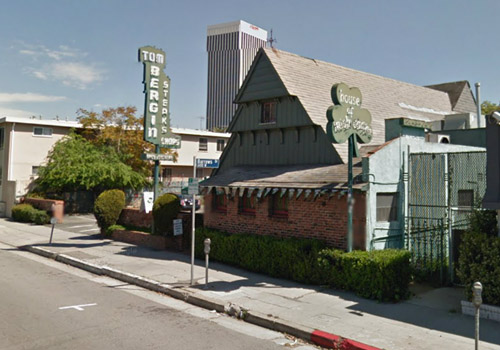
Everyone called it “Tom Bergin’s” or “Tom Bergin’s Tavern” but the real name of the place on Fairfax that closed at the beginning of July was Tom Bergin’s Old Horseshoe and Thoroughbred Club. It was also called “Tom Bergin’s Old Horseshoe Tavern” in some advertising and a lot of people referred to it by its advertising line emblazoned on a neon out front — “House of Irish Coffee.” By any name, it was one of the oldest restaurants in Los Angeles, having opened in 1936 on Wilshire Boulevard by a lawyer named Tom Bergin. It moved to its final building in 1949.
Tom Bergin’s sometimes claimed to have been the first restaurant in America to serve Irish Coffee. Other venues have claimed that honor and I don’t want to get into that. It was also one of about eight thousand bars in the country that claimed to have been an/the inspiration for the TV series, Cheers. Again, I am agnostic on the subject.
It closed last year for ten months for an extensive renovation but when it reopened, crowds did not flock to it, not even after a rave review from Jonathan Gold. My guess is it was done in by its location, which was near nothing. It wasn’t a great place to meet someone for a lunch confab. It wasn’t a great place to stop in for a bite on your way to or from something else. As the years roll by, Angelenos seem to be less willing to dine somewhere that isn’t super-convenient. It was always packed on St. Patrick’s Day for obvious reasons but rarely any other time. I never ate there post-renovation but before, it was one of those places that I liked due to its friendly atmosphere but the food was just too disappointing. Perhaps if I was a drinker, I might have liked it more.
But I liked the chummy feeling of the place and I liked the servers and staff, some of whom had been there for decades. I could have done without the paper shamrocks everywhere, each displaying the name of a patron but they weren’t the problem for me. The problem was that I always came out feeling like I must have ordered the wrong thing…
As I write this at the beginning of 2021, Tom Bergin’s is open and I hear good things about it. Once there’s no more Pandemic, I’ll try to get by there. If it’s as good as it used to be, I may become a regular.
Damiano Mr. Pizza
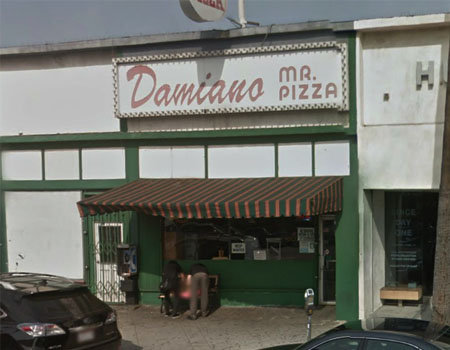
The last remaining outlet of Damiano Mr. Pizza closed unexpectedly at the end of May. Mitchell Kitay, the owner, told the press that he was forced out by the owners of the restaurant Animal, which had purchased the building two years ago. Whatever the reason, suddenly there was no more Damiano Mr. Pizza.
To the best of my knowledge, there were once three…this one, on Fairfax across from Canter’s; another one on Robertson two blocks south of Pico and the one I first visited, which was on Pico near Westwood. It was in a corner building that had previously been the original location of Junior’s Delicatessen and is now a Maria’s Italian Kitchen. The places were known variously as Damiano’s, Mr. Pizza and Damiano’s Mr. Pizza. I’d always assumed someone named Damiano bought a pizzeria that was already named Mr. Pizza and just tacked his name on the way a woman named Ruth bought the Chris Steak House and added her name to it. But that was just speculation. I don’t know if Mr. Kitay was the founder but perhaps someone who posts in the comments section will.
What I do know is that Damiano offered the closest thing to “New York Italian” I ever found in Los Angeles. The pizza was good — a bit greasy and a bit salty but quite tasty. Even better were the pasta dishes, especially anything with their slow-cooked meat sauce on it. I frequented all three outlets before the first two closed.
The one on Fairfax opened in ’64 and quickly became an institution in the area. It stayed open (and delivered!) until 6 AM…7 AM on weekends, which came in handy at times. In addition to great Italian food and beverages, the delivery guys could also bring you cigarettes…and one of their delivery guys told me once that at 5 AM, it was not unusual for someone to call up for a few cartons of Marlboro’s and then say, “While you’re at it, have him bring a pizza too.” Most of the delivery folks seemed like homeless people with cars and one friend of mine used to tip them extra to stop at the CVS Pharmacy and bring medicines or candy, as well. It was the one place at that hour you could phone and get someone to do that kind of thing for you.
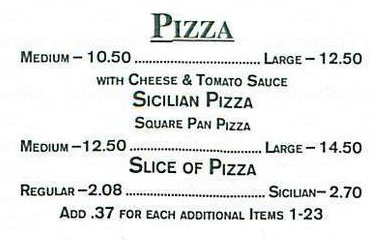
I often got deliveries from Damiano Mr. Pizza but around 1990, I stopped actually going into the restaurant. It was just too dilapidated, crowded and a little dirty. I assume they fixed it up after that — they would have had to — but the shabby surroundings diminished my love of their chow. It was though fun to watch the one guy on the phone juggling ten orders at once, hopping from one call on hold to another. There was one period there where I stopped ordering from them because the orders were always incorrect when they arrived…but after a year or so, I finally missed their food enough to give them another try and the first and all subsequent orders were right. You can imagine how much I’m going to miss them now. Mr. Kitay says he hopes to reopen in another location and I hope he does…but I’ll still miss the place on Fairfax. Even after I stopped setting foot inside, I was glad it was there…and delivering.
Cassell’s Hamburgers
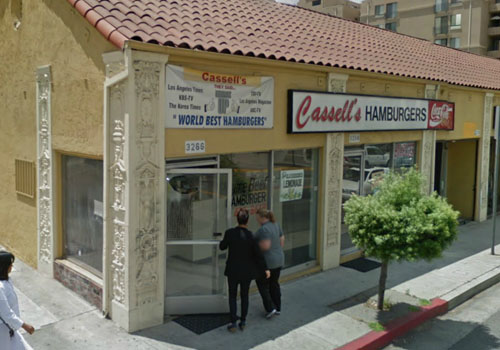
Cassell’s may not be completely defunct but its first two outlets certainly are, as are several short-lived “expansion” outlets in the eighties. Once upon a time, its name was the most often-given answer to the eternal question, “Where do you get the best hamburger in Los Angeles?”
Situated in Koreatown and open only for lunch, Cassell’s was the kind of place you took your friends, promising them something very special in a traditional burger. A Cassell’s burger was an expertly-cooked piece of prime U.S.D.A. beef served to you on a rather ordinary bun…and then you could dress it yourself. If you took a bite before condiments, you were impressed with how good the meat itself was. Some hamburgers are great because of the toppings applied to bland chopped meat. But the beef Al Cassell chose to use was the best you could use to make a hamburger and his unique slanted grill simultaneously broiled and fried it while the slant allowed excess grease to roll off. Another secret ingredient was the guy who ran the broiler. He’d cooked enough of them to know exactly the split-second to remove your burger from the fire.
Al Cassell opened Cassell’s Patio in 1948. He was said to be obsessive about quality, hollering at his suppliers if they didn’t deliver him the best lemons, the best onions, the best tomatoes. His homemade lemonade was especially exquisite and he was always tasting it himself and adjusting the sugar content. He also made his own mayonnaise on the premises…and then there was his potato salad. As good as Al’s hamburgers were, a lot of people thought the star of his limited menu was his unique potato salad.
Up until the mid-eighties, Cassell’s did not offer french fries. After you got your burger, you could help yourself to what he called the buffet. It was more like a topping bar: Ketchup, mustard, onions, his homemade mayo, lettuce, etc. There was cottage cheese and canned pineapple chunks and sometimes, other kinds of canned fruit. Mostly, there was this potato salad that looked like cold mashed potatoes. It was white and full of large chunks of spud, plus there was either a rather potent horseradish or hot mustard. Regular patrons of Cassell’s would argue over which it was and some would swear to have definitive information, sometimes from Mr. Cassell himself. This site declines to take sides in this vicious dispute.
The “hotness” in the potato salad, whatever it was, was hit and miss. You might get a scoop with very little of it. You might get one that would have you spitting flame. Most customers loved it but for those that didn’t want to risk the land mines, Mr. Cassell also provided a big basket of the smallest-sized bag of potato chips. You could grab a few of them and eat chips with your burger. (The potato chips went away when Cassell’s finally bowed to progress and introduced fries and later, onion rings. The new side dishes never seemed to sell that well, partly because the potato salad was so wonderful and partly because all you could eat of it was included with your burger, whereas you had to pay extra for fries or rings.)
There were other menu items at Cassell’s but not many. There was a pretty good ham sandwich, a pretty good egg salad sandwich and an excellent tuna salad sandwich. The glories of the last two had a lot to do with Mr. Cassell’s mayo.
He originally opened in ’48 at the corner of 6th Street and Berendo. Food critics discovered the place and it was very common to get there at lunchtime and find a line out the door. The quaint building had an actual patio and it was not unusual to spot Al out there, busing tables himself so as to seat customers who’d gotten and dressed their burgers and needed a place to sit and eat them. In the eighties, about the time fries appeared, he moved (grill and all) to a patio-less building a half-block east, still on 6th. That’s it in the photo above. Shortly after, a relative of Mr. Cassell’s opened an outlet in the shopping mall at Crescent Heights and Wilshire and did what appeared to be very good business. Then he handed the operation over to others and went out to open another Cassell’s on Ventura Boulevard in Encino. That one never caught on and in the meantime, the quality over at Crescent Heights plunged…and before long, both were gone.
In the nineties, Mr. Cassell’s health forced his retirement and he sold his beloved restaurant to a Korean family. They changed very little, mostly adding things like salmon burgers and chicken breasts, but you could feel the absence of Mr. Cassell. I found the quality variable. At its best, it was as good as ever. At its worst, it was still a better place to have a burger than most, including Hamptons, which I co-owned at the time…but it was no longer the kind of place restaurant critics raved about and the area was changing. Once upon a time, you couldn’t get in at lunch without a wait. Now, you could show up at 1:00 and be the only burger-eater in the house.
Mr. Cassell died in June of 2010. Two years later, his restaurant was closed. Another set of new owners were refurbishing the historic (built in 1928) Hotel Normandie a few blocks away and they planned to reopen Cassell’s there as part of that building. At the time, they said Cassell’s would be back in eight months with the old quality and some new menu items, including milk shakes.
As of this writing, it’s been a year and there’s no word of the comeback of Cassell’s. We hope it’ll be back and that much of Al Cassell’s way of making burgers will be in evidence. If so, it’ll be a great place…but it probably won’t match the glory days when Al himself was on the premises and you could hear him simultaneously tasting his lemonade and yelling on the phone at a supplier who’d delivered something less than the best lemons.
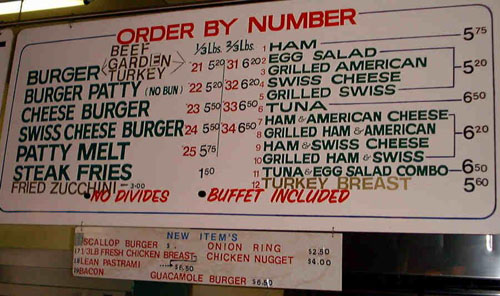
Carnegie Deli
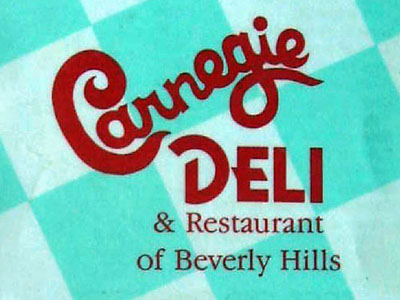
The Carnegie Deli in New York is a great and wonderful place…and probably more prosperous than ever since its neighbor, the Stage Deli, recently closed. The Carnegie Deli in Beverly Hills was not a great and wonderful place, which explains why it isn’t there any more.
In the early eighties, the Stage opened an outlet in Century City — also a pale imitation of its Manhattan ancestor but not quite as pale as the west coast Carnegie would be. In 1988 when the Schwab’s Drug Store at the corner of Crescent Heights and Sunset was razed, it was announced that the forthcoming shopping complex there would include an L.A. version of the Carnegie. Later, the plan was shifted to 300 N. Beverly Drive at the corner of Beverly and Dayton Way.
The buzz was that billionaire Marvin Davis had had a standing order every day at the Century City Stage Deli for a half-pound of lox, a half-dozen bagels, a pint of cream cheese and four bags of potato chips to be delivered to his office each morning. This did not satisfy him and he decided to open his own deli. (Another rumor was that he opened the Carnegie in Beverly Hills after he was made to wait too long for a table at Nate ‘n’ Al’s down the street.)
The opening on August 9, 1989 was a huge media event with celebrities including Don Rickles, Carol Channing, Billy Wilder and George Burns. Burns was so impressed with the place that he booked it for his 100th birthday party, which was to be held on January 20, 1996. George made it to that date but the deli didn’t. The opening was also attended by pickets as Davis and his partners had elected not to sign with the Hotel Employees and Restaurant Employees Union, Local 11. And there were also restaurant critics present, that evening and in subsequent weeks. Few of them liked what they ate.
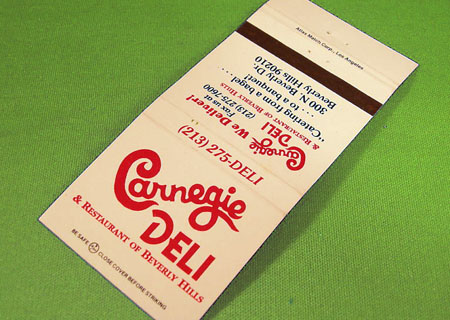
The place shut its doors on August 26, 1994 and someone had to call George Burns and tell him to find someplace else for his party. There were many reasons for the deli’s closure but the big three probably went something like this…
- Nate ‘n’ Al’s, a long-established local tradition, was right down the street.
- The food at the Carnegie cost more than the food at Nate ‘n’ Al’s.
- The food at the Carnegie wasn’t as good as the food at Nate ‘n’ Al’s.
Why couldn’t they at least replicate the quality of the original in New York? Probably some combination of management and suppliers not being as good. All I know is I ate there twice — once by choice and once because an agent I was lunching with insisted we meet there. I didn’t care for the meal either time and I didn’t care for that agent.
Sorrentino’s
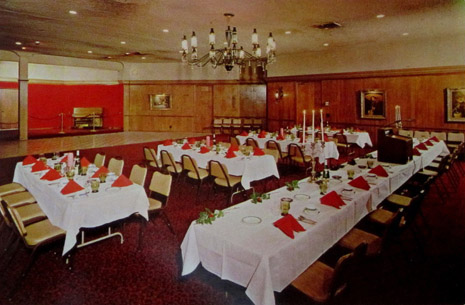
Sorrentino’s Seafood House was one of several Southland restaurants owned and operated by members of the Sorrentino family. It was located at the corner of Pass Avenue and Riverside in Burbank. A few blocks away was the more upscale Alfonse’s, run by the famous chef, Alfonse Sorrentino. The seafood restaurant was reportedly run by two of his cousins. Whoever ran it, it was a great place that at lunchtime was packed with folks in the entertainment industry.
I liked lunch at Sorrentino’s better than dinner, though both were great. At lunchtime, most entrees came with an amazing kind of potato I’ve never encountered anywhere else. It was halfway between the consistency of a baked potato and mashed — something like a pudding — and laced with onion. It was not listed as a side dish on the menu, which may explain why it didn’t seem to have a name. Every time I asked a waitress what it was called, the answer was “It’s just something the chef whips up at lunchtime.” He did not whip it up at dinner and believe me: I asked.
The photo above is of Sorrentino’s banquet room which got a lot of traffic from TV shows and movies holding wrap parties or press conferences. I rented it a few times on behalf of CAPS, the Comic Art Professional Society, back when I was on its Board of Directors. The food was good, the staff was great. The only reason I can imagine for its closure in the eighties was that they didn’t do as much business in the evenings as they did for lunch. An awful lot of deals were concluded and script meetings held in its lush, red booths. I miss it and I miss those potatoes.






Recent Comments